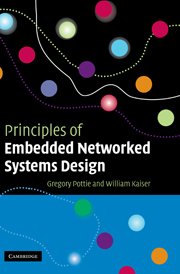Book contents
- Frontmatter
- Contents
- Preface
- Acknowledgments
- List of Abbreviations
- 1 Embedded network systems
- 2 Representation of signals
- 3 Signal propagation
- 4 Sensor principles
- 5 Source detection and identification
- 6 Digital communications
- 7 Multiple source estimation and multiple access communications
- 8 Networking
- 9 Network position and synchronization services
- 10 Energy management
- 11 Data management
- 12 Articulation, mobility, and infrastructure
- 13 Node architecture
- 14 Network data integrity
- 15 Experimental systems design
- 16 Ethical, legal, and social implications of ENS
- 17 Design principles for ENS
- Appendix A Gaussian Q function
- Appendix B Optimization
- Index
5 - Source detection and identification
Published online by Cambridge University Press: 10 August 2009
- Frontmatter
- Contents
- Preface
- Acknowledgments
- List of Abbreviations
- 1 Embedded network systems
- 2 Representation of signals
- 3 Signal propagation
- 4 Sensor principles
- 5 Source detection and identification
- 6 Digital communications
- 7 Multiple source estimation and multiple access communications
- 8 Networking
- 9 Network position and synchronization services
- 10 Energy management
- 11 Data management
- 12 Articulation, mobility, and infrastructure
- 13 Node architecture
- 14 Network data integrity
- 15 Experimental systems design
- 16 Ethical, legal, and social implications of ENS
- 17 Design principles for ENS
- Appendix A Gaussian Q function
- Appendix B Optimization
- Index
Summary
This chapter presents basic methods of detection and estimation theory, and applies them to the problem of the detection and identification of sources. Classical statistical methods are emphasized, with the problem being cast as a probabilistic and hierarchical matching of resources to the difficulty of the estimation and detection tasks. The basic approach is one of using the least resources by taking maximum advantage of domain knowledge.
Introduction to detection and estimation theory
Many problems in signal processing and communications consist of the detection of a signal in the presence of noise, or the identification of the category to which the signal belongs. Inherent in the latter type of problem is estimation of a number of parameters of the signal which form the basis of some hypothesis space. In detection problems, there are two hypotheses:
H0: desired signal absent;
H1: desired signal present.
In identification problems, there are generally a larger number of hypotheses among the various identification classes, including the possibility that no signal in a desired class is present.
In estimation problems by contrast the objective is to estimate some parameter set of the signal, e.g., the phase of a carrier wave in noise, or the sampled impulse response of a channel.
For all of these problems, from the observed random process Z(t) a sequence of decision variables Z0, Z1, …, ZN− 1 is extracted. For detection and identification problems, using this sequence, one of M hypotheses H0, …, HM− 1 is decided upon.
Information
- Type
- Chapter
- Information
- Principles of Embedded Networked Systems Design , pp. 109 - 151Publisher: Cambridge University PressPrint publication year: 2005
